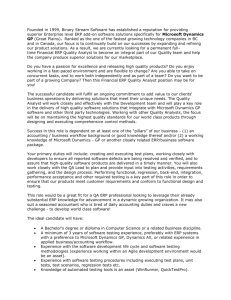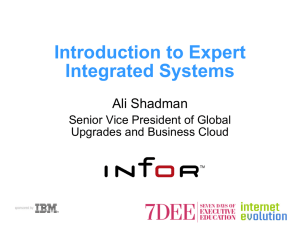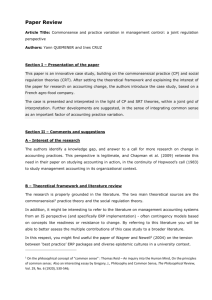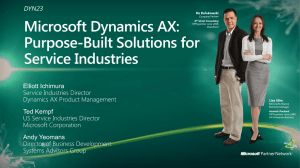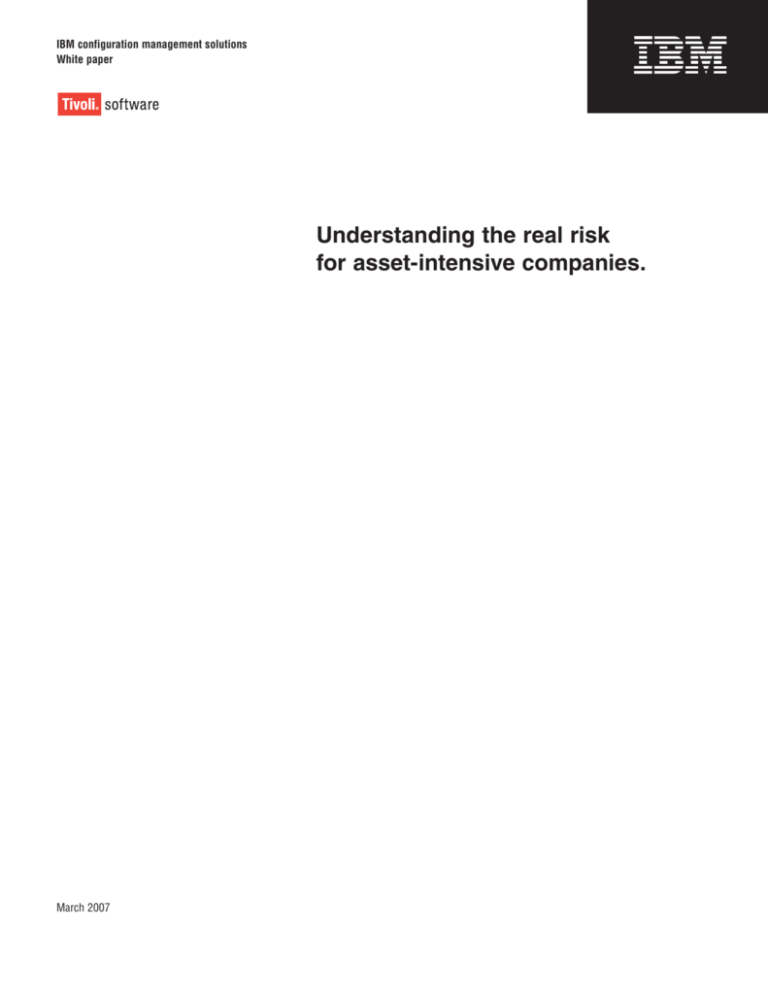
IBM configuration management solutions
White paper
Understanding the real risk
for asset-intensive companies.
March 2007
Understanding the real risk for asset-intensive companies.
Page 2
Contents
2 Executive summary
3 Myth 1: ERP solutions are sufficient to
manage the infrastructures of assetintensive companies
4 Myth 2: An ERP solution will lower IT cost
and risk
7 Myth 3: Integration of best-in-class
solutions and ERP is complex, risky and costly
11 Myth 4: EAM modules from large ERP
vendors are functionally rich and equal to Maximo
13 Myth 5: The best-run businesses use ERP only
13 Summary
15 For more information
15 About Tivoli software from IBM
Executive summary
The goal of having one enterprise resource planning (ERP) solution for all
business processes is still popular, yet the idea is no longer practical, particularly
in asset-intensive industries. Changing requirements in the areas of compliance
and risk management are increasing the pressure on an enterprise’s operations
group to manage their assets to higher standards and to demand the best
available solution for people, process and technology.
Changes in technology such as service-oriented architecture (SOA) and Web
services eliminate the need to compromise operational effectiveness. Platformoriented strategies of the large enterprise software vendors, and the adoption of
standards-based architectures, blur the boundaries between what is developed by
the large ERP vendors versus those with specific business-critical functions.
There are some common misconceptions about the value, capabilities and
deployment of ERP solutions in asset-intensive industries. In this white paper,
these myths are discussed and demystified so that decision makers in these assetintensive industries can better understand what the real risk is.
Understanding the real risk for asset-intensive companies.
Page Myth 1: ERP solutions are sufficient to manage the infrastructures of
asset-intensive companies
In asset-intensive industries, failure of a critical asset infrastructure can have a
detrimental impact on an organization not only from a financial perspective, but
also from a social and environmental viewpoint. For a multi-national company, an
asset failure can be the kind of event that makes headline news. This type of risk
or failure can often be measured in the hundreds of millions of dollars, a risk that
organizations cannot take lightly. When large companies look for asset management
solutions, it is imperative that they implement the best technologies available.
Company executives, sometimes supported by reports from renowned analyst
firms, may claim that the modules for managing assets that are part of the
financial systems are sufficient. But for organizations that manage critical asset
infrastructures, there is too much risk associated with this compromise. It
increases the operational risk for the organization and sends the wrong message
to its employees when a company selects an insufficient solution. The financial
performance of the company, the safety of the workforce and the preservation of
the environment are at stake.
Facts
• An asset-intensive company that experiences a severe safety or environmental incident can easily
incur a problem measured in the hundreds of millions of dollars.
• Part of the IBM Tivoli® software portfolio, IBM Maximo® Asset Management is considered the
“gold standard” for asset management.
Understanding the real risk for asset-intensive companies.
Page Highlights
ERP solutions force asset managers to create
unsupported applications in order to fill
functional gaps.
Myth 2: An ERP solution will lower IT costs and risk
Asset-intensive companies that use an ERP solution for asset management
typically end up with only 60 to 80 percent coverage of their functional
requirements. What about the remaining 20 to 40 percent? What do people
do when they have a need for application capabilities that the ERP solution
doesn’t support? They create their own solutions. Independent departments use
productivity tools to create applications “on the fly” to deal with changes in
regulatory requirements or changes in business process. These applications are
sometimes called renegade applications.
These applications are created to fill a functional gap in a larger system, such
as ERP, in order to enable the company to better complete its operational
mission. Often based in Microsoft® Excel®, Microsoft Access or some small niche
application, these stop-gap solutions/applications are generally not secure, not
supported by the IT organization and not auditable. They are costly to integrate
and are typically managed “under the radar” by one person or small group. The
implications of these types of applications are two-fold.
• They increase the cost of IT.
• They increase the operational and regulatory risk (e.g., Sarbanes-Oxley, Basel II) to the organization,
as there is no longer a single, readily auditable repository of information related to the assets.
Understanding the real risk for asset-intensive companies.
Page Figure1:Thelifecycleofarenegadeapplication
1 Evaluation
Change begins when a company evaluates
its IT strategy and realizes that:
• There are too many IT applications in use.
• The user base is too fragmented.
From here, a consolidation
strategy develops.
5 Actualization
The result — more disparate
applications supporting disjointed
processes and silos of information,
as opposed to one best-in-class ERP
system that best supports all users
and processes.
4 Regulation
2Typically,
Consolidation
an ERP system is
Managing
Change
New regulations can add information
management layers on top of current
requirements. Because corporate
systems are not flexible enough,
and scope of use cannot be easily
changed, users may resort
to personal productivity
tools to complete
business-critical
functions.
chosen to deploy across multiple
business functions, including asset
and service management.
3Internal
Realization
teams realize that they
cannot receive end-to-end support
for new business processes from the
new system, and start implementing
“one-off” solutions to meet
operational requirements.
For example, regulated industries are required to track deviations of intended
operations and follow a predefined process for root cause analysis. Large
ERP vendors do not offer corrective action modules to support these
requirements. Some companies build Access databases to address this problem.
Other companies buy niche applications to solve it. In both cases, these
applications need to be maintained, integrated and supported on top of the
enterprise application.
Understanding the real risk for asset-intensive companies.
Page Highlights
Unsupported applications increase operational
risk and cost.
ERP deployments are often funded by business cases that are based on reduction
of total cost of ownership (TCO) by rationalizing the application portfolio of the
enterprise, following the formula TCOEnterprise = TCOERP. It seems more correct
to extend this formula to take into account the impact of renegade applications:
TCOEnterprise = TCOERP + TCORenegade. Because they are not supported, renegade
applications are often a compliance risk. According to Section 404 of the
Sarbanes-Oxley Act, companies need to be able to ensure that applications
used to process information are fully documented and supported. So instead of
RiskEnterprise = RiskERP , the real risk to the enterprise is:
RiskEnterprise = RiskERP * RiskRenegade 1 * RiskRenegade n.
Organizations that use general-purpose ERP systems to manage their critical
asset infrastructure may be putting their companies at unnecessary risk and
expense. They may not be able to achieve their goal of application consolidation.
Instead, they could end up with an abundance of newly developed, unsupported
applications that not only increase the operational risk of the organization but
increase the cost of IT as well.
Facts
• TCOEnterprise = TCOERP + TCORenegade
• RiskEnterprise = RiskERP * RiskRenegade 1 * RiskRenegade n
• The chain is as weak as its weakest link (e.g., Renegade 1…Renegade n)
Understanding the real risk for asset-intensive companies.
Page 7
Myth 3: Integration of best-in-class solutions with ERP is complex, risky and costly
One of the old arguments in the enterprise vs. best-in-class debate is that it is
very costly to integrate a best-in-class solution with an ERP system, and that
any integration will increase the risk of the project. There are three points to
consider relative to this myth.
• In most cases, integration risk and operational risk are not equal.
• Integration technologies have changed dramatically over the last five years, enabling new levels of
integration.
• When evaluating integration, one should not only consider the integration between one solution and
the ERP but the integration for the entire ecosystem.
Companies that are managing critical asset infrastructures that can impact
people, the environment and the company’s financial performance should select
solutions that allow them to manage their assets to the highest standards in
the areas of safety, integrity and reliability. They should not trade off perceived
reductions in IT costs against placing their company at a higher risk (e.g., for
potential fines, prudent oversight, accidents, environmental problems, brand/
corporate reputation damage, etc.). Furthermore, integration technologies have
matured significantly over the past decade and, as a result of this, the actual cost
and risk of integration have changed as well.
Understanding the real risk for asset-intensive companies.
Page Point-to-point integration
With this older approach, applications are connected to each other with
dedicated integration points. Users generally build an interface for each
requirement using each application’s proprietary application programming
interfaces (APIs). These interfaces are built specific to the two applications and
tied to each other’s version and configuration, making the applications tightly
coupled. This type of integration is manageable on a small scale. However, it can
grow at an exponential rate and quickly get out of control as more applications
are connected to each other. For instance, a seemingly insignificant change in
one application could affect the interfaces with all other applications to which it
is connected, both directly and indirectly.
Hub-and-spoke integration
An update to point-to-point integration, applications are connected to a
central integration system, commonly referred to as an enterprise application
integration (EAI) hub. The EAI hub, in turn, provides integration services and
handles communication from application to application (spokes). While the
hub-and-spoke approach does promote centralized management, standardization
and reuse, the connections at the spoke typically require some effort.
Applications at the spokes may not have APIs, or have proprietary APIs that
require development and maintenance related to each change to the applications
(upgrades, enhancements, etc.).
Understanding the real risk for asset-intensive companies.
Page Service-oriented architecture
The most modern approach is SOA, an architectural framework for enterprise
application services and the interoperability of these services. In order to
implement SOA, applications are required to have discoverable, implementable
and reliable services. Also, SOA requires a robust platform and the means to
explore, discover and route services and messages. Enterprise Service Bus (ESB)
is the concept associated with the service invocation and routing aspects of SOA.
ESB relies heavily on the platform to manage and route service invocations,
events and messages.
Figure2:Integrationapproaches
Point-to-point integration
Hub-and-spoke integration
Service-oriented architecture
Understanding the real risk for asset-intensive companies.
Page 10
Highlights
SOA enables seamless integration with ERP applications.
This platform is key to SOA. The majority of the platform vendors, especially
the J2EE™ and Microsoft .NET platform vendors are implementing SOA
concepts and components into their platforms. Major ERP vendors, realizing
the importance and the momentum of SOA, have either built or acquired SOAcapable platforms and are expanding their application provider role to include
platform, integration and core services. One of the more recent entrants into
this arena is SAP NetWeaver, the enterprise services architecture that SAP has
established for deploying business solutions based on J2EE and Web services.
SAP acquired a number of technology vendors and began to consolidate these
technologies under the NetWeaver umbrella. NetWeaver offers an open standardsbased platform, portal and integration technology stack. It allows customers and
partners to extend the product to cover functional gaps. It also enables best-inclass vendors to leverage the platform, including the look and feel, to provide
seamless integration with ERP applications in a very cost-effective manner.
Facts
• Maximo software uses an architecture that is built on the same technology standards as the
platform architectures of the large enterprise vendors.
• IBM Maximo Asset Management has been certified for a number of applications including
NetWeaver Application Server and SAP Portals.
Understanding the real risk for asset-intensive companies.
Page 11
Myth 4: EAM modules from large ERP vendors are functionally rich and equal
to Maximo
The large ERP vendors claim that the functional footprint of their enterprise
asset management (EAM) modules will soon approach the footprint of Maximo,
the EAM market leader. In reality, the gap between Maximo and current ERP
solutions is wide and is likely to increase in some important areas. Maximo
uses an SOA architecture to quickly develop functional enhancements to the
application and bring them to market. These extensions are often organized
according to industries or asset classes and provide significant value for industries
that have specific asset management requirements, as shown in Figure 3.
Figure3:Industry-specificassetmanagementrequirements
Industry
Requirement
Regulated industries
Calibration, corrective action
Utilities
Compatible units estimating
Transportation
Warranty management, linear assets
Facilities
Key management
Federal government
Real property
Understanding the real risk for asset-intensive companies.
Page 12
Highlights
Positive user experiences promote acceptance
of asset and service management solutions.
The market has shifted its view of asset management as an internal function to
a view that asset management is a support service to the business. This concept
is called asset and service management and it involves creating a layer around
the asset management function that helps create alignment to the business. This
helps the business maximize return on assets against limited resources and
within a compliance framework. Further, this alignment ensures high reliability
at a lower cost. Asset and service management solutions are designed around the
people using them. They provide the user experience that drives the engineers to
use the system. These systems empower the user, which, in turn, drives higher
quality data. Without 100 percent acceptance of the system, it not only becomes
worthless, it can become dangerous.
This danger can be highlighted by the following example. In electric utilities,
before certain work can be done, the area where the people are working needs
to be powered down. The procedure to ensure that workers are entering an
area that is not electrified is called lockout/tagout. If the system doesn’t get used
because it is too cumbersome or hard to use, worker safety can be jeopardized.
Granted, what usually happens is that the engineers will develop a renegade
application to handle the requirement (see Myth 2). By doing so, management
won’t always know that there is a systems deficiency.
Facts
• The Maximo software portfolio has solutions that provide industry-specific functionality for Nuclear
Power, Utilities, Oil & Gas, Life Sciences and Transportation.
• Maximo’s rational consolidation provides businesses with a single set of processes for lower levels
of risk and higher levels of standardization. In addition, it helps IT achieve lower cost of ownership,
increased agility and a modern architecture that supports greater data visibility and process control.
Understanding the real risk for asset-intensive companies.
Page 1
Myth 5: The best run businesses use ERP only
Many of the best run businesses use solutions from large enterprise software
vendors. Often, SAP or Oracle is selected, but they may not be the best solution
for asset management. This ERP approach may make sense when the risk
profiles are low. However, in enterprises where the risk profile is high, such as
in asset-intensive organizations, you will find that for asset and service
management, a majority of the leading global companies use best-in-class
solutions like Maximo.
Fact
• All of the Fortune 100 companies use an ERP system to manage their businesses, but more than
half of these same Fortune 100 companies use Maximo to manage and service their businesscritical assets.
Summary
There are some common misconceptions about the value, capabilities and
deployment of enterprise solutions in asset-intensive industries. In this white
paper, these myths are discussed so that decision makers can better understand
the real risk. Figure 4 summarizes the myths identified in this paper and the
realities associated with them.
Understanding the real risk for asset-intensive companies.
Page 1
Highlights
Integratingbest-in-classassetmanagement
canincreasethevalueofERPinvestments.
Figure4:ERPmythsandrealities
Myth
Reality
ERP solutions are sufficient to manage
the infrastructures of asset-intensive
companies.
Potential risks associated with an
asset failure mean ERP solutions are
not appropriate in asset-intensive
industries.
An ERP solution will lower IT cost
and risk.
Functional gaps and changes in
process lead to renegade applications
that increase the risk and cost of IT
and operations.
Integration between best-in-class
solutions and ERP is complex, risky
and costly.
Advances in technology have
mitigated the risk and reduced the
cost of integration.
EAM modules from large ERP vendors
are functionally rich and approaching
the capabilities of Maximo.
Functional enhancements of
the Maximo portfolio have widened
the gap when compared to ERP
modules.
The best run businesses use ERP only.
Most of the best run companies also
use best in-class solutions like Maximo.
The business process platforms that ERP companies now provide serve as a great
foundation for developing a seamlessly integrated environment that is based on
solutions from multiple vendors. Organizations can view this as an opportunity
to use best-in-class solutions that are built on the right architecture as a way to
increase the value of their ERP investments. Use of Maximo Asset Management
as a strong operational system can enhance the quality of asset data, contribute
to the safety of the workforce, and help facilitate best practices that directly and
significantly impact the long-term success of the business.
Understanding the real risk for asset-intensive companies.
Page 1
For more information
To learn more about IBM Maximo Asset Management, contact your IBM
representative or IBM Business Partner, or visit ibm.com/tivoli or maximo.com
About Tivoli software from IBM
Tivoli software provides a comprehensive set of offerings and capabilities in
support of IBM Service Management, a scalable, modular approach used to
deliver more efficient and effective services to your business. Meeting the needs
of any size business, Tivoli software enables you to deliver service excellence
in support of your business objectives through integration and automation
of processes, workflows and tasks. The security-rich, open standards-based
Tivoli service management platform is complemented by proactive operational
management solutions that provide end-to-end visibility and control. It is also
backed by world-class IBM Services, IBM Support and an active ecosystem of
IBM Business Partners. Tivoli customers and partners can also leverage each
other’s best practices by participating in independently run IBM Tivoli User
Groups around the world — visit www.tivoli-ug.org
© Copyright IBM Corporation 2007
IBM Corporation Software Group
Route 100
Somers, NY 10589
U.S.A.
Produced in the United States of America
3-07
All Rights Reserved
IBM, the IBM logo, Maximo and Tivoli are trademarks of International Business Machines
Corporation in the United States, other countries or both.
Java and all Java-based trademarks are trademarks of Sun Microsystems, Inc. in the United
States, other countries or both.
Microsoft, Windows, Windows NT, and the Windows logo are trademarks of Microsoft Corporation
in the United States, other countries, or both.
Other company, product and service names may be trademarks or service marks of others.
References in this publication to IBM products and services do not imply that IBM intends to
make them available in all countries in which IBM operates.
No part of this document may be reproduced or transmitted in any form without written permission
from IBM Corporation.
Product data has been reviewed for accuracy as of the date of initial publication. Product data is
subject to change without notice. Any statements regarding IBM’s future direction and intent are
subject to change or withdrawal without notice, and represent goals and objectives only.
THE INFORMATION PROVIDED IN THIS DOCUMENT IS DISTRIBUTED “AS IS” WITHOUT ANY
WARRANTY, EITHER EXPRESS OR IMPLIED. IBM EXPRESSLY DISCLAIMS ANY WARRANTIES
OF MERCHANTABILITY, FITNESS FOR A PARTICULAR PURPOSE OR NON-INFRINGEMENT.
IBM products are warranted according to the terms and conditions of the agreements (e.g. IBM
Customer Agreement, Statement of Limited Warranty, International Program License Agreement,
etc.) under which they are provided.
IBM customers are responsible for ensuring their own compliance with legal requirements. It is the
customer’s sole responsibility to obtain advice of competent legal counsel as to the identification
and interpretation of any relevant laws and regulatory requirements that may affect the customer’s
business and any actions the customer may need to take to comply with such laws.
TIW10322-USEN-00



